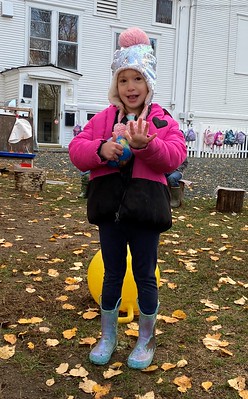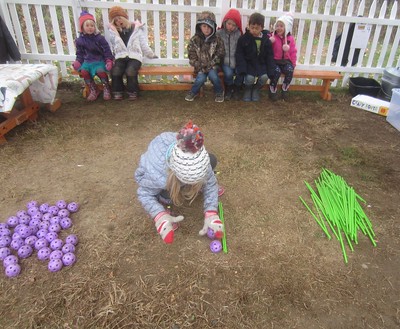The abstract artist Wassily Kandinsky is probably most well known for his painting Squares with Concentric Circles, which along with his Several Circles inspired our art for the week. The children used various sized circles dipped in black paint to begin their own circle themed art, which they will finish next week when they paint in and around their circles.
In our further exploration of our earth, made up of land, air, and water, we began to learn about the water cycle. We sang our water cycle song about precipitation, evaporation, and condensation. It goes like this:
When the water comes down it’s precipitation, precipitation, precipitation. When the water comes down it’s precipitation. Precipitation comes down. When the water goes up it’s evaporation, evaporation, evaporation. When the water goes up it’s evaporation. Evaporation goes up. When the water comes together it’s condensation, condensation, condensation. When the water comes together it’s condensation. Condensation makes a cloud.
We did an experiment to show that when water heats up it turns into tiny droplets, evaporating up into the sky. Then as the tiny droplets cool and gather together, condensing, they become too heavy and fall back down, precipitate.
We celebrated a sixth birthday! The birthday girl donated a fun story about going on a leaf hunt and finding leaves from different trees, which we enjoyed reading. Our birthday girl is an old pro at the birthday ritual, so she quickly informed us that she was born in the fall and that the earth has gone around the sun 6 times since she was born. We named the seasons and counted the years as she orbited the big sun ball with the globe.
We began to discuss emotions and recognizing them on people’s faces and in their body language. The children would guess what emotions Lyn was expressing and we discussed how to help calm and handle those emotions. We used the suggested strategies in the song “If You’re Happy and You Know It,” adding in get a hug when you are sad, walk away when you are angry, and take some breaths when you are frustrated.
During sign Language with Rose we learned about name signs. Rose old us that in the deaf community, people are given or create their own name sign, typically using the first letter of their first name and something that reflects something about that person. For example, Rose’s name sign is the letter R and the sign for flower. She told us that we would each get a name sign, but this week the children would be helping to give the three teachers name signs. She showed us the signs for teacher, power, and heart, and they gave the teacher’s name signs using their first initial and the sign for heart. She then taught us the signs for our Five Little Pumpkins sitting on a Gate chant, which was a lot of fun!
We had tortoise and hare visit and chat with us a little. They acted out the story of their first race and how hare tired out from running so fast, so he stopped to take a nap and tortoise won the race because he continued on at a slow, steady pace. We discussed times when it is good to go fast, and times when it is good to slow down. The children had lots of ideas about when and where to change their body speed. We also talked about slowing down our speech to be more clear and understandable, and slowing down our responses to questions and thinking about them before answering.
Zeanny introduced the greeting song and how we might respond. She showed some faces expressing different emotions, and we learned that triste is sad, feliz is happy, enojado is angry, and preocupado is preocupied. She tried to trick us by changing the faces to see if we could identify the emotion, changing her expression and voice to match the emotion. We sang the songs about the body, then did colors and tempo with the egg shakers. Finally she began reading El Loro Tico Tango, which we will finish up next week.
Kindergarten students had another busy week counting and finding counting patterns, building numbers with their Cuisenaire rods and rods and balls, and working on their letters and letter sounds by coloring and cutting out pictures of items beginning with the letter sounds they are working on.
Friday students furthered their study of water by exploring objects that sink and float. The children took turns picking an item, describing what it was made of, and making a prediction about whether it would sink or float before testing their hypothesis. We learned pretty quickly that things made of wood or plastic typically float, and items made of clay, glass and metal sink. With further exploration we will likely discover that shape plays a factor as well.





































































